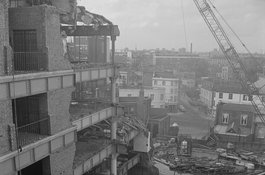Living at 49 Gower's Walk
Contributed by eric on Oct. 27, 2016
Circa 1952, no. 49 Gower’s Walk belonged to Messrs Faircloughs the meat transporters, and at ground level consisted only of a pair of large wooden doors opening into part of Fairclough premises. Above these doors were two flats having a common front door at ground level. At that time I was a schoolboy living in one of these flats, and my bedroom looked out on to the huge Tilbury Warehouse opposite.
I have bought old images of Gower's Walk, showing where I lived, but copyright for these exists elsewhere. Some images I obtained from Tower Hamlets Archives, showing things before the current houses in Gower’s Walk were built. There were also buildings at nos 47 and 46 Gower's Walk, but by 1950 these had disappeared or were defunct. When doing my family research I made fleeting contact with a lady whose parents had lived at 46 Gower’s Walk. I have found that the volume of history just in the one block bordered by Gower’s Walk and Back Church Lane is mind blowing.
The discomfort of cycling over cobbles in the 1940s
Contributed by eric on Nov. 1, 2016
Memories of Eric Shorter, b. 1936
Early on my parents bought me a sit-up-and-beg bike. When I wore that out, they bought me a second-hand road racing machine, so light I could just about lift it with one finger. It had large-diameter thin wheels and a Brooks B17 saddle – not far from being just a strip of leather. It had one fixed high gear. Fine, but it wasn’t designed for the cobbles of Gower's Walk or London. At one time I could recognise individual stones in a set of cobbles outside our front door, and knew what to avoid. But I had to ride daily, else my bum would suffer. If for any reason I didn’t ride for a week or two then when I did, I knew I would have to renegotiate the pain barrier of ’hardening the bum for the road’.
A narrow escape at the old 49 Gower's Walk in the 1940s
Contributed by eric on Nov. 1, 2016
Memories of Eric Shorter, b. 1936
Ours was the top-floor flat, with interesting storage places beneath the sloping roof. The floors were wooden, with much woodworm that we treated regularly. There were no carpets, though my mum made some by sewing small folded strips of material offcuts on to hessian backing. When first there, I was young and had a three-wheeled kiddies' tricycle, that I used to ride around. The noise that this made on the wooden boards annoyed the people in the flat below, and I was ‘told off’.
I also nearly killed myself at a young age. To me at one stage my trike was a fire engine, and a fire engine has to have a hose and somewhere to get water. Improvisation is a great thing. A section of old rope was the hose, and I tied one end of it to a length of electric cable I found lying around with a plug on the end and bare wires on the other.. I plugged the cable into a wall socket in our lounge. I remember right now finding my mum and saying that the cable had ‘bitten me’. I had had a narrow escape.
Faircloughs yards and the east side of Gower's Walk in the early 1950s
Contributed by eric on Nov. 2, 2016
Memories of Eric Shorter, b. 1936
As I walked it, ran it, cycled it, the Gower's Walk that I knew in the early 1950s was structured as I now describe. It runs roughly north/south and was cobbled throughout. The eastern side of Gower's Walk consisted roughly of three parts.
The top third, right up to Commercial Road, was ‘commercial’ and belonged to Faircloughs, the meat transporters. Mostly there were very tall brick walls, that had Fairclough loading/garage bays behind them, but in the middle of these was an entrance to the Fairclough Yards [on the site of 52 and 53 Gower's Walk], with a long on-high narrow office where arriving vehicles could be ‘clocked in’. There was also another wooden-doored exit/entry to Fairclough yards/garages, above which were two occupied flats, at no 49. Next door was no 48, a soap factory, and I believe that beyond that were the uninhabited remains of defunct dwellings at 47 and 46. No 46 was, I think, on the corner of Gower's Walk and Webb's Place before that was fenced off. At the very top of Gower's Walk was the side of a commercial building whose address was 52 Commercial Road, but it features in my memories.
